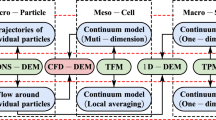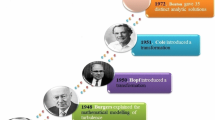Abstract
Moving particle semi-implicit (MPS) method is a fully Lagrangian particle method which can easily solve problems with violent free surface. Although it has demonstrated its advantage in ocean engineering applications, it still has some defects to be improved. In this paper, MPS method is extended to the large eddy simulation (LES) by coupling with a sub-particle-scale (SPS) turbulence model. The SPS turbulence model turns into the Reynolds stress terms in the filtered momentum equation, and the Smagorinsky model is introduced to describe the Reynolds stress terms. Although MPS method has the advantage in the simulation of the free surface flow, a lot of non-free surface particles are treated as free surface particles in the original MPS model. In this paper, we use a new free surface tracing method and the key point is “neighbor particle”. In this new method, the zone around each particle is divided into eight parts, and the particle will be treated as a free surface particle as long as there are no “neighbor particles” in any two parts of the zone. As the number density parameter judging method has a high efficiency for the free surface particles tracing, we combine it with the neighbor detected method. First, we select out the particles which may be mistreated with high probabilities by using the number density parameter judging method. And then we deal with these particles with the neighbor detected method. By doing this, the new mixed free surface tracing method can reduce the mistreatment problem efficiently. The serious pressure fluctuation is an obvious defect in MPS method, and therefore an area-time average technique is used in this paper to remove the pressure fluctuation with a quite good result. With these improvements, the modified MPS-LES method is applied to simulate liquid sloshing problems with large deforming free surface. Results show that the modified MPS-LES method can simulate the large deforming free surface easily. It can not only capture the large impact pressure accurately on rolling tank wall but also can generate all physical phenomena successfully. The good agreement between numerical and experimental results proves that the modified MPS-LES method is a good CFD methodology in free surface flow simulations.
Similar content being viewed by others
References
Abramson, H. N., 1966. The Dynamic Behavior of Liquid in Moving Containers, NASA SP-106.
Armenio, V. and Rocca, L. M., 1996. On the analysis of sloshing of water in rectangular containers: numerical study and experimental validation, Ocean Eng., 23(8): 705–739.
Carious, A. and Casella, G., 1999. Liquid sloshing in ship tanks: a comparative study of numerical simulation, Marine Structures, 12(3): 183–198.
Delorme, L., Colagrossi, A., Souto-lelesias, A., Zamora-Rodriguze, R. and Botia-Vera, E., 2009. A set of canonical problems in sloshing, Part I Pressure field in forced roll comparison between experimental results and SPH, Ocean Eng., 36(2): 168–178.
Gotoh, H., Shibahara, T. and Sakai, T., 2001. Sub-particle-scale turbulence model for the MPS method-Lagrangian flow model for hydraulic engineering, Computational Fluid Dynamic Journal, 9(4): 339–347.
Gotoh, H. and Sakai, T., 2006. Key issues in the particle method for computation of wave breaking, Coast. Eng., 53(2–3): 171–179.
Graham, E. W. and Rodriguez, A. M., 1952. The characteristics of fuel motion which affect airplane dynamics, Journal of Applied Mechanics, 19, 381–388.
Hibi, S. and Yabushita, K., 2004. A study on reduction of unusual pressure fluctuation of MPS method, Journal of Kansai Society Naval Architects, 241, 125–131.
Housner, G., 1957. Dynamic pressure on accelerated fluid containers, Bulletin of the Seismological Society of America, 47(1): 15–35.
Hwang, J. H., Kim, I. S., Seol, Y. S., Lee, S. C. and Chon, Y. K., 1992. Numerical simulation of liquid sloshing in 3-Dimensional tanks, Computers and Structures, 44(1–2): 339–342.
Koshizuka, S., Tamako, H. and Oka, Y., 1995. A particle method for incompressible viscous flow with fluid fragmentation, Journal of Computational Fluid Dynamics, 4(1): 29–46.
Koshizuka, S. and Oka, Y., 1996. Moving-particle semi-implicit method for fragmentation of incompressible fluid, Nuclear Science and Engineering, 123(3): 421–434.
Landrini, M., Colagorossi, A. and Faltisen, O. M., 2003. Sloshing in 2D flows by the SPH method, Proceeding of the 8th International Conference on Numerical Ship Hydrodynamics, Busan, Korea, 1–15.
Löhner, R., Yang, C. and Oñate, E., 2007. Simulation of flows with violent free surface motion and moving objects using unstructured grids, International Journal for Numerical Methods in Fluids, 53(8): 1315–1338.
Mikelis, N. E. and Journee, J. M., 1984. Experimental and numerical simulations of sloshing behavior in liquid tanks and its effect on ship motion, National Conference on Numerical Methods for Transient and Coupled Problem, Venice, Italy.
Nakayama, T. and Washizu, K., 1981. The boundary element method applied to the analysis of two-dimensional nonlinear sloshing problems, International Journal for Numerical Methods in Engineering, 17(11): 1631–1646.
Olsen, H. A. and Johnsen, K. R., 1975. Nonlinear Sloshing in Rectangular Tanks: A Pilot Study on the Applicability of Analytical Models, Det Norske Veritas Report 74-72-S, vol. II.
Pan, X. J., Zhang, H. X. and Lu, Y. T., 2008a. Moving-particle semi-implicit method for vortex patterns and roll damping of 2D ship sections, China Ocean Eng., 22(3): 399–407.
Pan, X. J., Zhang, H. X. and Lu, Y. T., 2008b. Numerical simulation of viscous liquid sloshing by moving-particle semi-implicit method, Journal of Marine Science and Application, 7(3): 184–189.
Pan, X. J. and Zhang, H. X., 2008a. Moving-particle semi-implicit method for simulation of liquid sloshing on roll motion, Journal of Shanghai Jiao Tong University, 42(11): 1904–1907.
Pan, X. J. and Zhang, H. X., 2008b. A study on the oscillations appearing in pressure calculation for sloshing simulation by using moving-particle semi-implicit method, Chinese Journal of Hydrodynamics, 23(4): 453–463. (in Chinese)
Pan, X. J., 2009. Moving-Particle Semi-Implicit Method Research and Application Based on Large Eddy Simulation, Ph. D. Thesis, Shanghai Jiaotong University. (in Chinese)
Rakheja, S., Sankar, S., Ranganathan, R., Billing, J. R. and Mercer, W., 1991. Field testing of a tank truck and study of fluid sloshing, Proceedings of International Truck & Bus Meeting & Exposition, SAE paper 912679.
Strandberg, L., 1978. Lateral Stability of Road Tankers, VTI report 138A, National Swedish Road and Traffic Research Institute, Sweden.
Sueyoshi, M. and Naito, S., 2001. A study of nonlinear fluid phenomena with particle method (Part1), Journal of Kansai Society Naval Architects, 236,191–198. (in Japanese)
Sueyoshi, M. and Naito, S., 2002. A study of nonlinear fluid phenomena with particle method (Part2), Journal of Kansai Society Naval Architects, 237,181–186. (in Japanese)
Yu, K., 2007. Level-Set RANS Method for Sloshing and Green Water Simulations, Ph. D. Thesis, Texas A&M University.
Author information
Authors and Affiliations
Corresponding author
Additional information
This work was financially supported by the National Natural Science Foundation of China (Grant No. 50979059).
Rights and permissions
About this article
Cite this article
Pan, Xj., Zhang, Hx. & Sun, Xy. Numerical simulation of sloshing with large deforming free surface by MPS-LES method. China Ocean Eng 26, 653–668 (2012). https://doi.org/10.1007/s13344-012-0049-6
Received:
Revised:
Accepted:
Published:
Issue Date:
DOI: https://doi.org/10.1007/s13344-012-0049-6




